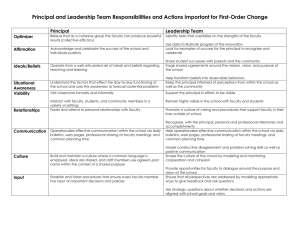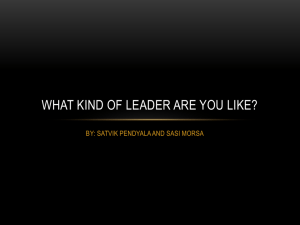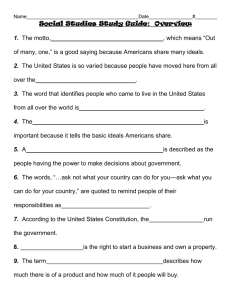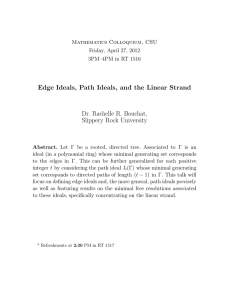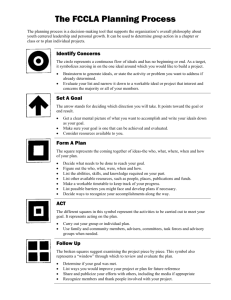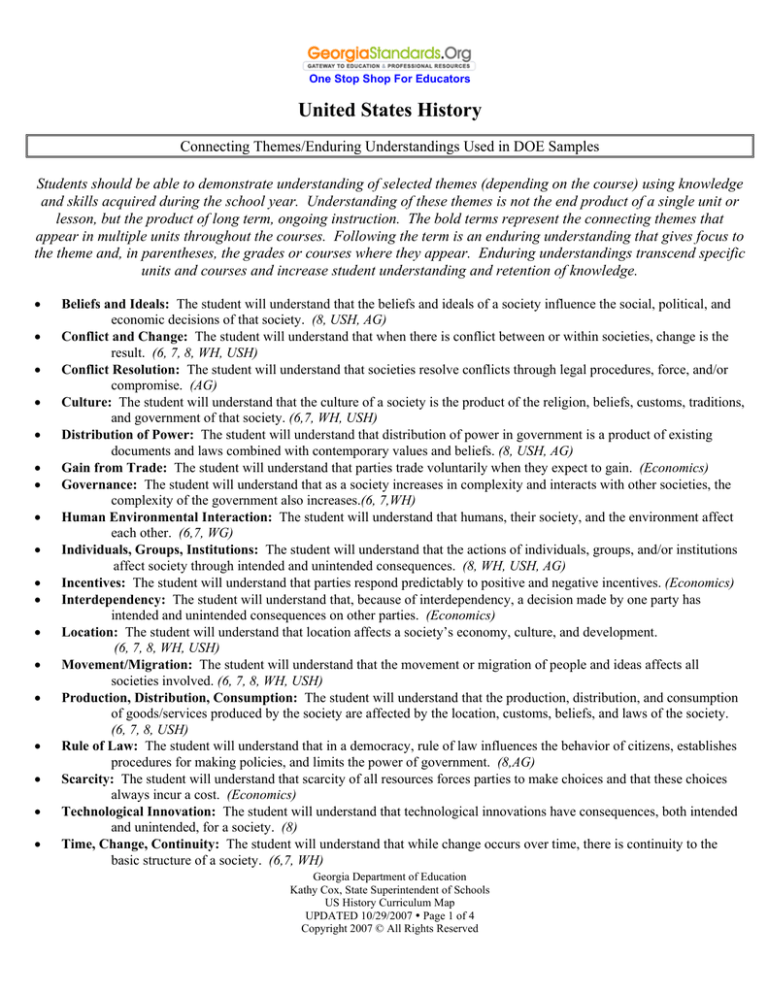
One Stop Shop For Educators
United States History
Connecting Themes/Enduring Understandings Used in DOE Samples
Students should be able to demonstrate understanding of selected themes (depending on the course) using knowledge
and skills acquired during the school year. Understanding of these themes is not the end product of a single unit or
lesson, but the product of long term, ongoing instruction. The bold terms represent the connecting themes that
appear in multiple units throughout the courses. Following the term is an enduring understanding that gives focus to
the theme and, in parentheses, the grades or courses where they appear. Enduring understandings transcend specific
units and courses and increase student understanding and retention of knowledge.
•
•
•
•
•
•
•
•
•
•
•
•
•
•
•
•
•
•
Beliefs and Ideals: The student will understand that the beliefs and ideals of a society influence the social, political, and
economic decisions of that society. (8, USH, AG)
Conflict and Change: The student will understand that when there is conflict between or within societies, change is the
result. (6, 7, 8, WH, USH)
Conflict Resolution: The student will understand that societies resolve conflicts through legal procedures, force, and/or
compromise. (AG)
Culture: The student will understand that the culture of a society is the product of the religion, beliefs, customs, traditions,
and government of that society. (6,7, WH, USH)
Distribution of Power: The student will understand that distribution of power in government is a product of existing
documents and laws combined with contemporary values and beliefs. (8, USH, AG)
Gain from Trade: The student will understand that parties trade voluntarily when they expect to gain. (Economics)
Governance: The student will understand that as a society increases in complexity and interacts with other societies, the
complexity of the government also increases.(6, 7,WH)
Human Environmental Interaction: The student will understand that humans, their society, and the environment affect
each other. (6,7, WG)
Individuals, Groups, Institutions: The student will understand that the actions of individuals, groups, and/or institutions
affect society through intended and unintended consequences. (8, WH, USH, AG)
Incentives: The student will understand that parties respond predictably to positive and negative incentives. (Economics)
Interdependency: The student will understand that, because of interdependency, a decision made by one party has
intended and unintended consequences on other parties. (Economics)
Location: The student will understand that location affects a society’s economy, culture, and development.
(6, 7, 8, WH, USH)
Movement/Migration: The student will understand that the movement or migration of people and ideas affects all
societies involved. (6, 7, 8, WH, USH)
Production, Distribution, Consumption: The student will understand that the production, distribution, and consumption
of goods/services produced by the society are affected by the location, customs, beliefs, and laws of the society.
(6, 7, 8, USH)
Rule of Law: The student will understand that in a democracy, rule of law influences the behavior of citizens, establishes
procedures for making policies, and limits the power of government. (8,AG)
Scarcity: The student will understand that scarcity of all resources forces parties to make choices and that these choices
always incur a cost. (Economics)
Technological Innovation: The student will understand that technological innovations have consequences, both intended
and unintended, for a society. (8)
Time, Change, Continuity: The student will understand that while change occurs over time, there is continuity to the
basic structure of a society. (6,7, WH)
Georgia Department of Education
Kathy Cox, State Superintendent of Schools
US History Curriculum Map
UPDATED 10/29/2007 y Page 1 of 4
Copyright 2007 © All Rights Reserved
One Stop Shop For Educators
The following instructional plan is part of a GaDOE collection of Unit Frameworks, Performance Tasks, examples of Student Work, and Teacher Commentary for the United
States History Course.
United States History
Standards: The focus of this important
Standards: 1, 2
Standards: 3, 4, 5
Standards: 6, 7
first unit is on the concepts and
enduring understandings rather than
specific standards.
Unit One focus:
Unit two focus:
Unit three focus:
Unit four focus:
Concepts found in United
States History
European Settlement of
North America
Creation of the United
States
Early Expansion
CONFLICT & CHANGE
•
Early relations with Native
Americans (1a,b)
•
Religious tensions (1b)
•
International conflict over
colonies (1c, d)
CULTURE
•
Great awakening (2d)
•
Social norms (2c)
DISTRIBUTION OF POWER
•
Early legislatures (1a, 1b)
INDIVIDUALS, GROUPS, &
INSTITUTIONS
•
Important people of the era (2c)
LOCATION
•
Importance of location to
settlements (1)
MOVEMENT/MIGRATION
•
Free vs. forced migration (1,
2b)
•
Trans-Atlantic trade (2a, b)
CONFLICT & CHANGE
•
Imperialism and revolution(3a)
•
British actions leading to
revolution(3b)
•
French alliance (4b)
•
End of revolutionary war (4d)
•
Events leading up to the
Constitution and creation of the
Constitution (5a,b,c, d)
BELIEFS & IDEALS
•
Important documents
expressing ideals (3c, 4a)
•
Federalists/Anti-federalists (5b)
INDIVIDUALS, GROUPS, &
INSTITUTIONS
•
Important people of the era (3c,
4a,b,c,d, 5b, d)
RULE OF LAW
•
Key features of Constitution
and Bill of Rights (5c, d)
BELIEFS & IDEALS
•
Reform movements (7c,d)
CONFLICT & CHANGE
•
Growing national identify (6c,e,
7e)
INDIVIDUALS, GROUPS, &
INSTITUTIONS
•
Important people of the era (6b,
7a,d)
MOVEMENT/MIGRATION
•
Territorial growth (6a,b, 7b)
TECHNOLOGICAL
INNOVATION
•
Erie Canal, New York,
Infrastructure (6d)
•
Industrial revolution, cotton
gin(7a)
•
BELIEFS & IDEALS
•
CONFLICT & CHANGE
•
CULTURE
•
DISTRIBUTION OF
POWER
•
INDIVIDUALS, GROUPS, &
INSTITUTIONS
•
LOCATION
•
MOVEMENT/MIGRATION
•
PRODUCTION,
DISTRIBUTION, &
CONSUMPTION
•
RULE OF LAW
•
TECHNOLOGICAL
INNOVATION
Georgia Department of Education
Kathy Cox, State Superintendent of Schools
US History Curriculum Map
UPDATED 10/29/2007 y Page 2 of 4
Copyright 2007 © All Rights Reserved
One Stop Shop For Educators
United States History
Standards: 8, 9, 10
Standards: 15a,b,c; 16a; 19b,c,d,e;
20; 24c; 25a,c,d,e,g
Standards: 11-14
Standards: 17; 18a,b,c,e; 22a; 23a,c;
25f
Unit Five focus:
Unit Six focus:
Unit focus:
Unit focus:
Clash of Beliefs and
Ideals
Expansion and Reform
Isolation vs. Globalization
Changing Role of
Government
BELIEFS & IDEALS
•
Slavery concerns (8a)
•
Nullification crisis (8c)
•
Lincoln’s actions (9b, c)
•
Reconstruction issues
(10a,b,d,e)
CONFLICT & CHANGE
•
Pre-civil war compromises
(8b,e)
•
War with Mexico (8d)
•
Acts/cases related to slavery
(9a)
•
Important battles of the civil
war (9d)
•
Constitutional Changes (10c)
INDIVIDUALS, GROUPS, &
INSTITUTIONS
•
Important people of the era (9c)
PRODUCTION,
DISTRIBUTION, &
CONSUMPTION
•
Economic disparities (9f)
BELIEFS & IDEALS
•
Changing role of women (13b)
•
Reform movements (13a,d,e)
CONFLICT & CHANGE
•
Emergence of NAACP (13c)
INDIVIDUALS, GROUPS, &
INSTITUTIONS
•
Trusts/Monopolies (11c)
•
Labor groups (12b,d)
MOVEMENT/MIGRATION
•
Immigration issues (12a, 14a)
•
Westward expansion (12c)
•
US involvement beyond our
borders (14b, c)
BELIEFS & IDEALS
•
Ideals vs. reality (15a,c)
•
Influence of events on ideals
(20a)
CONFLICT & CHANGE
•
WWI in the US (15b)
•
WWII related issues (19b,c,d)
•
Containment issues (20b,c,d)
INDIVIDUALS, GROUPS, &
INSTITUTIONS
•
Impact of individuals on
globalization (25a,c,d,e,g)
MOVEMENT/MIGRATION
•
Changing patterns (15b, 16a)
TECHNOLOGICAL INNOVATION
•
Impact of Railroads (11a,b, 14a)
•
Inventions (11d)
TECHNOLOGICAL INNOVATION
•
Los Alamos (19e)
•
Panama Canal (14c)
Georgia Department of Education
Kathy Cox, State Superintendent of Schools
US History Curriculum Map
UPDATED 10/29/2007 y Page 3 of 4
Copyright 2007 © All Rights Reserved
BELIEFS & IDEALS
•
Meeting needs of citizens
(18a,b,c, 23c)
•
Personal rights (23a)
CONFLICT & CHANGE
•
Economic changes (17a,b,c)
•
Role of government in
integration (22a)
•
Political changes (18e, 25a,d)
DISTRIBUTION OF POWER
•
Who decides? (25f)
INDIVIDUALS, GROUPS, &
INSTITUTIONS
•
Impact of individuals on
globalization (25a,b,c,d)
MOVEMENT/MIGRATION
•
Changing patterns (15b, 16a)
One Stop Shop For Educators
United States History
Standards: 15d; 18d 19a; 22b-e;
23b; 24;
Unit focus:
Unit Focus:
Social Movements
Cultural Change
BELIEFS & IDEALS
•
Rise of conservatism (24f)
•
Importance of individual rights
(25b)
CONFLICT & CHANGE
•
Women’s movements (15d,
24b)
•
Civil rights (22c,e, 23b, 24a,c)
INDIVIDUALS, GROUPS, &
INSTITUTIONS
•
•
Standards: 16b-d; 21; 23d; 25b
BELIEFS & IDEALS
•
Individual choice (23d, 25b)
CULTURE
•
Expressions (16d)
•
Baby boom and impact (21a)
TECHNOLOGICAL INNOVATION
•
•
•
The affordable auto (16b, 21a)
Entertainment (16c, 21b,c)
International (21d)
Civil rights (19a, 22b,d)
Taking a stand (18d, 24d,e)
Georgia Department of Education
Kathy Cox, State Superintendent of Schools
US History Curriculum Map
UPDATED 10/29/2007 y Page 4 of 4
Copyright 2007 © All Rights Reserved

